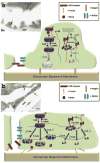Enzymatic disease of the podocyte
- PMID: 20130922
- PMCID: PMC4109305
- DOI: 10.1007/s00467-009-1425-1
Enzymatic disease of the podocyte
Abstract
Proteinuria is an early sign of kidney disease and has gained increasing attention over the past decade because of its close association with cardio-vascular and renal morbidity and mortality. Podocytes have emerged as the cell type that is critical in maintaining proper functioning of the kidney filter. A few genes have been identified that explain genetic glomerular failure and recent insights shed light on the pathogenesis of acquired proteinuric diseases. This review highlights the unique role of the cysteine protease cathepsin L as a regulatory rather than a digestive protease and its action on podocyte structure and function. We provide arguments why many glomerular diseases can be regarded as podocyte enzymatic disorders.
Figures




References
-
- Hogg RJ, Portman RJ, Milliner D, Lemley KV, Eddy A, Ingelfinger J. Evaluation and management of proteinuria and nephrotic syndrome in children: recommendations from a pediatric nephrology panel established at the National Kidney Foundation conference on proteinuria, albuminuria, risk, assessment, detection, and elimination (PARADE) Pediatrics. 2000;105:1242–1249. - PubMed
-
- Pavenstadt H, Kriz W, Kretzler M. Cell biology of the glomerular podocyte. Physiol Rev. 2003;83:253–307. - PubMed
-
- Reiser J, Kriz W, Kretzler M, Mundel P. The glomerular slit diaphragm is a modified adherens junction. J Am Soc Nephrol. 2000;11:1–8. - PubMed
-
- Patrakka J, Tryggvason K. New insights into the role of podocytes in proteinuria. Nat Rev Nephrol. 2009;5:463–468. - PubMed
-
- Reiser J, Oh J, Shirato I, Asanuma K, Hug A, Mundel TM, Honey K, Ishidoh K, Kominami E, Kreidberg JA, Tomino Y, Mundel P. Podocyte migration during nephrotic syndrome requires a coordinated interplay between cathepsin L and alpha3 integrin. J Biol Chem. 2004;279:34827–34832. - PubMed
Publication types
MeSH terms
Substances
Grants and funding
LinkOut - more resources
Full Text Sources
Medical
Miscellaneous

